The @hbdstabilizer started operating in February 2021. In its four years of operation, it has gone through different amounts of funds, from very small up to big sums, and then a pullback in the last year.
The bot is operated by @smooth. Let’s take a look at the data.
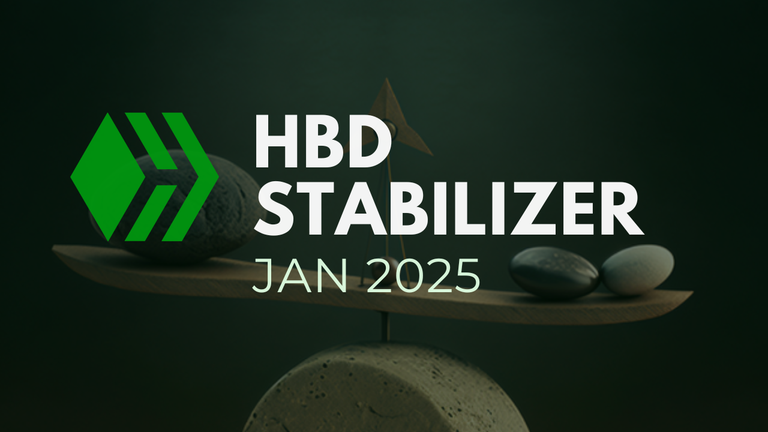
At the top the stabilizer was asking for 240k HBD per day. In the last years it has scaled back and now it is operating at 12k HBD per day. The HBD price is still holding well, meaning the funds are doing the job for now.For those who are not familiar with the project, the job of the @hbdstabilizer is to keep the HBD peg around the dollar, by trading HIVE and HBD on the internal market. It is a bot that provides liquidity for HBD around the dollar. It does this with funds that are received from the Decentralized Hive Fund DHF.
Lower funds for the stabilizer should provide opportunity for other participants to make their own proposals and create more bots that do similar job, so it is more decentralized. There seems to be other bots operating on the internal market now, also providing liquidity for HBD.
We have two scenarios/modes of the stabilizer operation.
- Buying HBD
- Selling HBD
HBD is paired on the internal market with HIVE so the trading is in the two native Hive currencies.
1.Buying HBD
When HBD is below the peg then the stabilizer is buying HBD to bring the HBD value to $1. Because, it receives HBD from the DHF, first it converts the HBD to HIVE, and then uses HIVE on the internal market to buy HBD. Buying HBD means selling HIVE.
Selling HBD
If the price of HBD is above the dollar then the stabilizer is selling HBD to bring it back to $1. The stabilizer receives HBD from the DHF, sells it on the internal market for HIVE and sends back the HIVE to the DHF, where it is instantly converted to HBD so it can be used from the DHF.
From the description above we can conclude that the @hbdstabulizer is receiving funds in HBD only, but it is returning funds in HBD and HIVE. To be able to compare the received vs returned funds we will need to convert the HIVE sent to the DHF in HBD.
HBD Received from the DHF
As already mentioned, the DHF is paying funds only in HBD. Here is the chart for the HBD transferred to the stabilizer.
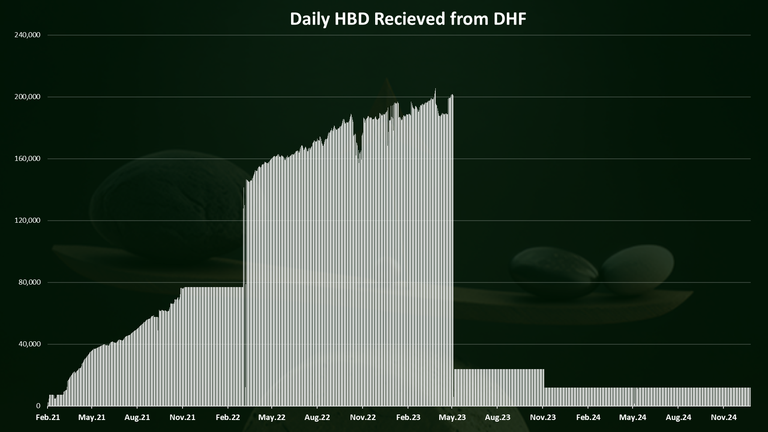
At first the amount of funds for the stabilizer grew. At the peak in April 2023 the stabilizer had a 200k HBD daily budget.
This growth was following the growth of the HBD funds in the DHF, as the stabilizer was asking 240k funds, but the daily budget was lower than that.
Then a cut in May 2023 to 24k HBD per day, and again a reduction in funds to 12k per day in November 2023, where we are still now.
HBD Sent to the DHF
As mentioned above the stabilizer is sending funds to the DHF in the form of HIVE and HBD. The HIVE is converted to HBD. Here is the chart.
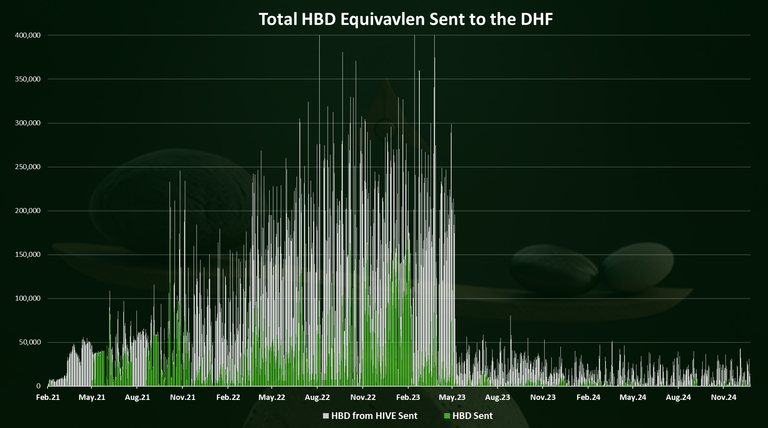
Note that funds sent to the @hive.fund are in the form of HIVE and HBD. I have converted the HIVE rewards to HBD, for easy representation and comparison.
We can see that the majority of the funds that the stabilizer sends back to the DHF has been in the form of HIVE and then those are instantly converted back to HBD in the DHF. This is understandable as the stabilizer is mostly buying HBD and it needs HIVE to do that. When it doesn’t need the funds it sends them back in the form of HBD.
We can see that for most of the time it had extra funds, and it was sending them back. Just on a few occasions it was using them all. We can also notice the scaling back in the operation of the stabilizer. In the last year it has reduced the funds its operating with quite a lot.
HBD Received VS Sent
monthly basis we get this.If we plot the amount of HBD received VS sent to the @hive.fund from the @hbdstabilizers on a
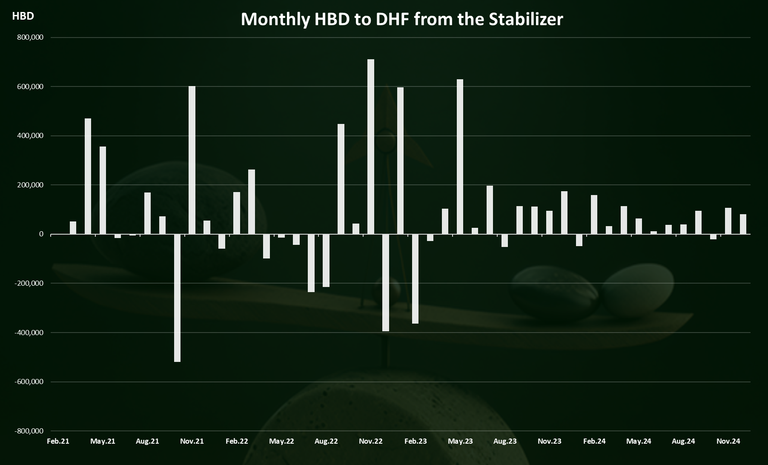
A positive bar means that the stabilizer has sent more funds to the DHF then received, a net profit, while a negative bar means that the stabilizer has received more funds then sent back, or a net loss.
What’s interesting from the chart above is that when HBD loses its peg on the market, even on the downside, usually then it is when the stabilizer makes profit.
We can see that the bars are now smaller most likely because of the lower amount of funds that the stabilizer receives. Also, most of the months the stabilizer is slightly positive meaning adding more funds to the DHF. This is the case for almost all of 2024 and the second half of 2023.
When we add the above the cumulative HBD added in the DHF from the @hbdstabilizer looks like this.
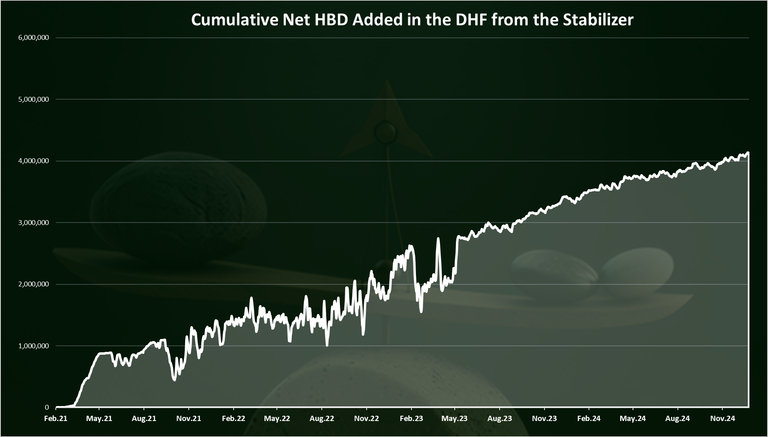
More than 4M HBD profit for the DHF from the @hbdstabilizer.
We can see that there was some ups and downs in 2023, but the overall trend has been up. With the lower funds that the stabilizer has now, the movements are lower, but still going up.
The hbdstabilizer profitability is a combination of the trading HBD that it is making on the internal market, and the conversions from HBD to HIVE. Also, the stabilizer is a beneficiary to the comments rewards of the @hbd.funder that are being upvoted daily from large stakeholders and this provides more than 200k HIVE equivalent per month.
As mentioned above the @hbdstabilizer is constantly making HBD to HIVE conversions in order to have HIVE and buy HBD if needed. The thing is these conversions take 3.5 days and have a market risk in them, and sometimes they can be market positive, while other times negative. Because the stabilizer has been making a relatively big amounts in conversions, those can add up.
HBD Sold VS Bought
Let’s take a look at the market activities and how much selling and buying the stabilizers has been doing.
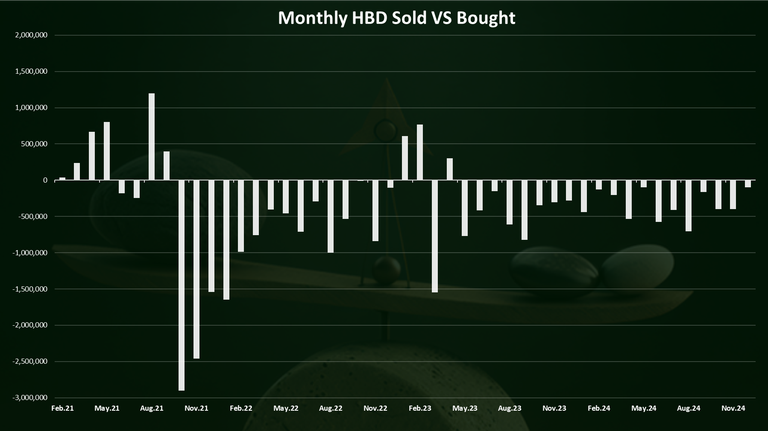
Positive bar means the stabilizer is selling HBD, negative bar means it is buying HBD.
As we can see from the chart the stabilizer has been mostly buying HBD in the past. In the first few months it has been selling more HBD because at the time the HIVE to HBD conversions were not enabled on the blockchain and HBD was constantly trading above $1. When the HIVE to HBD conversion was enabled, HBD returned to its peg and since then the stabilizer has been mostly in buying mode for HBD supporting the price on the downside.
In the last period this trend has continued as well with the stabilizer mostly buying HBD. Although the numbers are now much lower and the volatility as well.
In the last months of 2024 the stabilizer bought between 100k to 300k HBD per month on the internal market.
The cumulative data for the amount of HBD bought from the stabilizer looks like this.
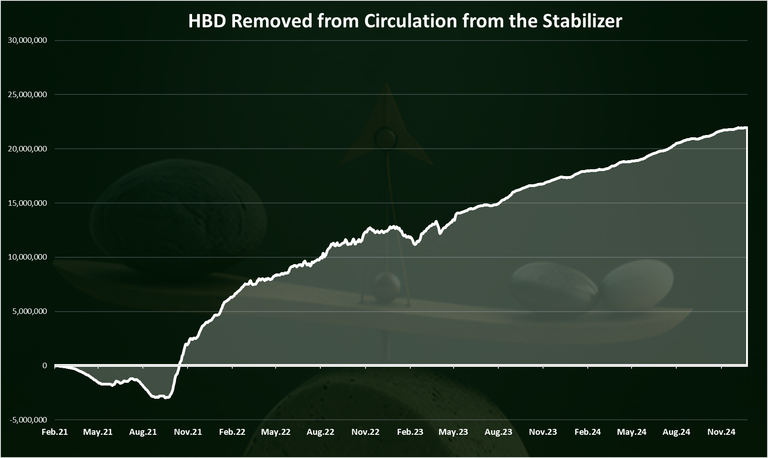
We can see that at the start in the period February – July 2021, the stabilizer was selling more HBD. Then at the end of 2021 it started buying more HBD, because the HBD supply expanded meanwhile and there were excess amounts in a hands of speculators.
In the last period the amount of HBD buys has been lower and the line has flatten out, although still with a trend for growth.
In total the stabilizer has removed 22M HBD from circulation in its period of operation, out of which around 5M HBD in 2021, 8M in 2022, 5M in 2023 and 4.5M in 2024.
HBD Price
At the end the chart for the HBD price in the period.
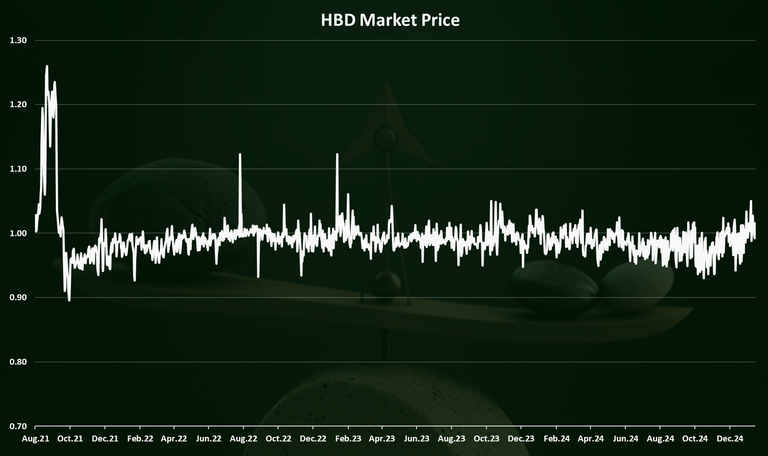
We can see that back in 2021 the price of HBD was above the peg of one dollar. This is because the HIVE to HBD conversions were not active in the period, the bull market was on, and the speculators pushed the price of HBD above one dollar.
Since September 2021 HBD has been far more stable although not ideal. On a few occasions the price increased to more than $1.1 but only for a short period, and on a few occasions, it has dropped to around 0.95. Still much better than in the last period.
Note that these are external market prices, sometimes they are based on very low trading volume and can be inaccurate, while the on chain price has been at the peg at all time, and users can convert HBD to HIVE for one dollar at any time.
Summary
The conversions that the stabilizer is now doing previously were mostly made by users themselves.The main takeaway from the above is that the @hbdstabilizer has been helping the HBD peg on the downside and has removed a total of 22M HBD from circulation in the last four years. There has been a downtrend since 2021 in the overall need for support, with 2024 with the lowest funds needed for support. It is worth noting that on the other side of the equation for supporting the HBD price, the activities on the internal market, conversions, buying HBD on the internal market, is putting more HIVE in circulation, increasing the overall inflation for HIVE. The pro is more stable and liquid HBD.
As far as the DHF goes, the stabilizer has added more than 4M HBD to its budget. Some of it is from authors rewards as beneficiary.
Since September 2021, the price of HBD has been relatively stable, with very short-lived spikes to 1.2 and drops to around 0.95.
The internal market has increased liquidity and HBD now has the most liquidity there, thanks to the stabilizer.
In the last years the stabilizer has decreased its funding from 240k to 24k and then to 12k per day.
All the best
@dalz
It didn't work very well (quickly enough) during the recent Hive pump to around 0.69. For those wanting to sell Hive for HBD (and hold the HBD) it was not feasible for several days.
If swapping Hive to HBD with purpose to arbitrage by sending HBD to Upbit, the sure it would be useful, but that's not the purpose of the HBD Stabiliser.
@smooth
What you're seeing is the effect of an immature and small market. The stabilizer along with the natural incentives of the blockchain ensure that HBD will return to peg "soon" after these sorts of disruptions. In a more mature market there would be more traders competing to take advantage of the opportunity for a few percent return over a few days (realistically you shouldn't make more than a small fraction of a percent in a few days on a low risk trade), and this would keep these deviations small and short.
Fortunately the stabilizer has a dual purpose. It pushes the price back toward the peg but it also generates profit from DHF and in the course of doing so produces net buying pressure for HIVE. The more and bigger the deviations, the bigger the profit. So Hive stakeholders benefit either way.
If the stabilizer had more funding would it be able to return to peg more quickly?
Probably, but trade offs:
Thanks for your replies.
Re. 3. Is the account multi-sig? And is that the only risk of it being hacked - by getting hold of the keys somehow?
There is a server running the bot code that needs constant access to the account to perform the trades and transfers so one way or another the keys have to be online.
I have to agree with @smooth here.
Market is a futures market for hive price feed in 3.5 days. What you advocate for is a "money losing" automation.
Very enlightening post, thank you.
Just a few days ago my brain melted trying to understand how this process unfolds. This parity of the HBD and always being on track, with more or less a tenth of escape.
How was all this processed, was it manually? How many people would be needed to collect all the data to carry out the operations? Who would trade HIVE for HBD and buy HIVE again, and then trade again? How does it all stabilize?
Not being a person in the field of economics and finance, I was curious to understand this whole process. How the heart of the hive works. Or, rather, the engine of the entire financial operations machine.
With this article my brain became calmer. You can see that this bot created by Smoot is charming, a functional marvel.
(Translated with DeepL.com)
Internal market is a futures market for the "price feed" price of Hive in 3.5 days.
Its all math.
So far, to me HBD has been performing pretty well containing the peg. Good job @smooth
So @smooth
I was not aware of this information.
Greetings from Venezuela, my friend.Thank you, @dalz Every day I learn more about the complex and wonderful world of #Hive and decentralized currencies.
Whoa! some cool charts.. really shows the flow of HBD. I really like HBD and its 1 of 2 cryptos that I still trade lots. (the other is HIVE)
GO HBD!! 💪😎🤙
!PIZZA
How is 'peg' calculated by these bots?